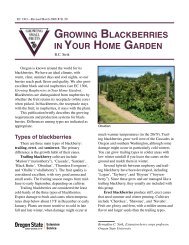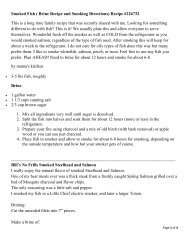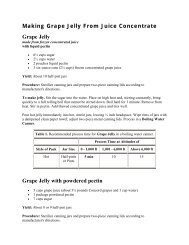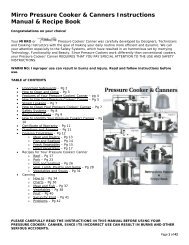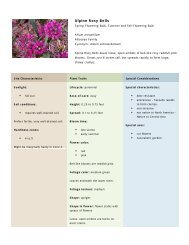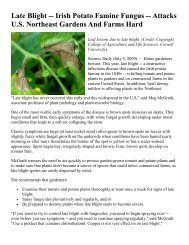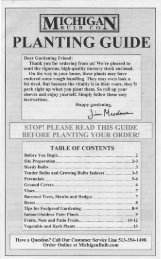Strawberry and Raspberry Pest Management in Wisconsin
Strawberry and Raspberry Pest Management in Wisconsin
Strawberry and Raspberry Pest Management in Wisconsin
You also want an ePaper? Increase the reach of your titles
YUMPU automatically turns print PDFs into web optimized ePapers that Google loves.
Table 6. Spray schedule for strawberries—BEARING BEDS<br />
When to spray Problem Treatment Formulation Rate/acre Remarks<br />
EARLY SPRING Diseases<br />
(after uncover<strong>in</strong>g plants;<br />
diseases should be treated<br />
as leaves are exp<strong>and</strong><strong>in</strong>g)<br />
leaf diseases:<br />
angular leaf spot<br />
(see remarks)<br />
leaf blight<br />
leaf scorch<br />
leaf spot<br />
captan 50WP 3.0–6.0 lb<br />
copper various see label<br />
dod<strong>in</strong>e 65WP 1.5–2.0 lb<br />
myclobutanil 40W 2.5–5.0 oz<br />
propiconazole EC 4.0 fl oz<br />
To control leaf diseases, start spray<strong>in</strong>g before<br />
symptoms appear on foliage.<br />
If angular leaf spot has been a problem <strong>in</strong> previous<br />
years, <strong>in</strong>clude a copper fungicide (see “Disease<br />
Notes”). Copper may cause a slight chlorosis or<br />
yellow<strong>in</strong>g of the foliage of some varieties;<br />
discont<strong>in</strong>ue use if phytotoxicity occurs.<br />
red stele mefenoxam Gold EC 1.0 pt Apply <strong>in</strong> sufficient water to move the fungicide to<br />
the root zone.<br />
Insects<br />
PREBLOOM Insects<br />
(separation of<br />
blossom buds)<br />
aphids<br />
cyclamen mite<br />
aphids<br />
plant bugs<br />
spittlebug<br />
fosetyl alum<strong>in</strong>um 80WDG 2.5–5.0 lb Apply <strong>in</strong> sufficient water to thoroughly wet foliage.<br />
phosphorous acid rates vary Formulations <strong>and</strong> rates vary. See product labels.<br />
endosulfan 50WP 2.0 lb<br />
3EC 1.3 qt<br />
malathion 25WP 6.0–8.0 lb<br />
8EC, 8F 1.5–2.0 pt<br />
acetamiprid 30 SG 1.9-6.9 oz<br />
70 WP 0.8-3.0 oz<br />
*bifenthr<strong>in</strong> WSB 6.4–32.0 oz<br />
carbaryl 80S 1.5–2.5 lb<br />
50WP 2.0–4.0 lb<br />
4F, XLR 1.0–2.0 qt<br />
endosulfan 50WP 2.0 lb<br />
3EC 1.3 qt<br />
malathion 25WP 6.0 lb<br />
cyclamen mite endosulfan 50WP 4.0 lb<br />
3EC 2.66 qt<br />
strawberry leafroller<br />
thrips<br />
*bifenthr<strong>in</strong> WSB 6.4–32.0 oz<br />
carbaryl 80S 1.5–2.5 lb<br />
50WP 2.0–4.0 lb<br />
4F, XLR 1.0–2.0 qt<br />
endosulfan 50WP 2.0 lb<br />
3EC 1.3 qt<br />
malathion 25WP 6.0 lb<br />
sp<strong>in</strong>etoram SC 6.0-10.0 fl oz<br />
sp<strong>in</strong>osad Entrust 1.25–1.5 oz<br />
Sp<strong>in</strong>Tor 4.0–6.0 fl oz<br />
2SC<br />
spider mite *abamect<strong>in</strong> 0.15EC 16.0 fl oz<br />
*bifenthr<strong>in</strong> WSB 16.0–32.0 oz<br />
fenbutat<strong>in</strong> oxide 50WP 1.5–2.0 lb<br />
*fenpropathr<strong>in</strong> 2.4EC 16.0–21.3<br />
fl oz<br />
strawberry bud<br />
weevil (clipper)<br />
*bifenthr<strong>in</strong> WSB 6.4–32.0 oz<br />
chlorpyrifos 4E 1.0 qt<br />
If cyclamen mites are a problem, make a separate<br />
application of endosulfan 3EC at 2.66 qt (or 50WP at<br />
4 lb) <strong>in</strong> 400 gal spray per acre (also controls aphids,<br />
spittlebugs, <strong>and</strong> plant bugs).<br />
Two aphicide treatments <strong>in</strong> spr<strong>in</strong>g before bloom<br />
<strong>and</strong> two <strong>in</strong> fall before mulch<strong>in</strong>g help control spread<br />
of strawberry viruses <strong>in</strong> new <strong>and</strong> bear<strong>in</strong>g fields.<br />
Carbaryl may aggravate aphid <strong>and</strong> spider mite<br />
problems.<br />
*Fenpropathr<strong>in</strong> can be used for control of tarnished<br />
plant bug <strong>and</strong> spittlebug at the rate of 10.67 fl oz/a.<br />
Acetamiprid may also be used for thrips control at the<br />
rate of 4.0-6.9 oz/acre (30 SG formulation) or 1.7-3.0<br />
oz/acre (70 WP formulation).<br />
If strawberry bud weevil has been a problem, two<br />
applications are suggested 10 days apart. Chlorpyrifos<br />
may be phytotoxic when applied <strong>in</strong> hot weather.<br />
* Restricted-use pesticide—can only be applied by a certified applicator. (cont<strong>in</strong>ued)<br />
21




